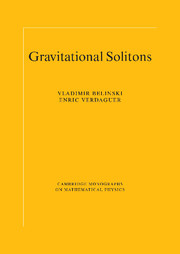Book contents
- Frontmatter
- Contents
- Preface
- 1 Inverse scattering technique in gravity
- 2 General properties of gravitational solitons
- 3 Einstein–Maxwell fields
- 4 Cosmology: diagonal metrics from Kasner
- 5 Cosmology: nondiagonal metrics and perturbed FLRW
- 6 Cylindrical symmetry
- 7 Plane waves and colliding plane waves
- 8 Axial symmetry
- Bibliography
- Index
4 - Cosmology: diagonal metrics from Kasner
Published online by Cambridge University Press: 17 August 2009
- Frontmatter
- Contents
- Preface
- 1 Inverse scattering technique in gravity
- 2 General properties of gravitational solitons
- 3 Einstein–Maxwell fields
- 4 Cosmology: diagonal metrics from Kasner
- 5 Cosmology: nondiagonal metrics and perturbed FLRW
- 6 Cylindrical symmetry
- 7 Plane waves and colliding plane waves
- 8 Axial symmetry
- Bibliography
- Index
Summary
One context in which the ISM described in chapter 1 has been widely used is the cosmological context, especially for the generation of exact inhomogeneous cosmological models. The purpose of this and the next chapter is to review such applications and to provide an overview of the corresponding soliton solutions and their physical significance.
In this chapter we concentrate on spacetimes that can be described by a diagonal metric obtained as soliton solutions from a Kasner background. This background, which is a homogeneous but anisotropic cosmological model, is reviewed in section 4.2. Section 4.3 is devoted to the characterization of diagonal metrics. Several physical relevant quantities including the Riemann tensor in an appropriate frame, the optical scalars and the Bel–Robinson superenergy tensor which are useful for the interpretation of these diagonal metrics in the cosmological context, and also in the cylindrically symmetric and plane-wave contexts, are introduced. A brief review of some key equations of the ISM adapted to canonical coordinates is given in section 4.4. The ISM is then used to generate diagonal soliton solutions. Since the relevant field equations for diagonal metrics are linear, the soliton solutions can be generalized in several ways. The relation between these solutions and the known general solution of the linear problem is given, and the solutions are classified according to the type (real or complex) and the number of pole trajectories which define them. The solutions with real poles are discussed in section 4.5.
- Type
- Chapter
- Information
- Gravitational Solitons , pp. 92 - 132Publisher: Cambridge University PressPrint publication year: 2001



